To understand what a turbocharger is, what it does, and how it works. First, let us take a look at the "Triangle of Fire".

1. Oxygen
2. Fuel
3. Heat
The same goes in a combustion engine. In a combustion engine, the air (Oxygen) mixes with fuel, the spark plug generates enough heat to make the explosion, generating enough power to move the piston down.
You can increase the output power of an engine by increasing the amount of intake "Air" and "fuel"to generate a much more powerful explosion.
In the old days, the easiest way to increase the power was to use bigger carburetors, which used much more fuel to generate power.
Nowadays, to make the engines more efficient yet powerful, instead of forcing fuel (you can do also do it with the help of ECU, "Engine Control Unit," which is another topic to discuss), car manufacturers focus on forcing more air into the piston to increase the power of an engine. This matter is possible with the help of turbochargers & superchargers. (Which we will cover only turbochargers)
What Is A Turbocharger?
As mentioned above, a turbocharger forces air into pistons to increase the overall power, but how?
You see, a turbocharger is basically two scrolls attached via a shaft, which means if any of the scrolls spins, the other one spins with the same speed as well.

What Is An Intercooler?
To make this system work more efficiently, we need to ensure that the air is not hot!
We know from physics that hot air is less dense than cooler air. Therefore, we keep the temperature low to keep the density low. For this reason, we use an intercooler in between the air intake scroll and the air intake manifold. The intercooler cools down the temperature of the in-going air using water to make sure the engine gets more air! (The cooler the air the better)

I hope this article helped you understand how turbochargers work and how they increase an engine's power!
As a bonus, I will explain what a "turbo lag is"!
What Is A Turbo Lag?
Since we understand how turbochargers work, we know that exhaust gas exiting the engine is the only force that spins the scrolls. At normal 1000 RPM (round per minute), the scrolls do not spin as fast as they should; hence they do not force more air into the engine, but when you step on the gas and you increase the RPM, more exhaust gas exits which spins the scrolls, therefore more air is pushed to the engine.
Now the time it takes for the scrolls to start spinning at a high rpm is called "Turbo Lag"!